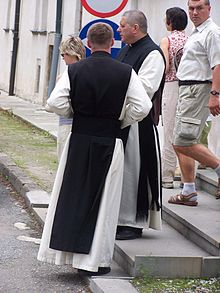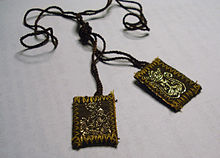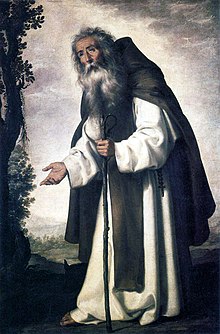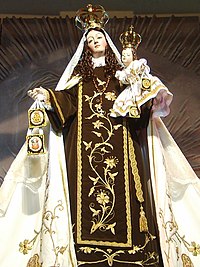
The Order of the Brothers of the Blessed Virgin Mary of Mount Carmel, known as the Carmelites or sometimes by synecdoche known simply as Carmel, is a mendicant order in the Catholic Church for both men and women. Historical records about its origin remain uncertain; it was probably founded in the 12th century on Mount Carmel in what is now Israel.

The Scapular of Our Lady of Mount Carmel belongs to the habit of both the Carmelite Order and the Discalced Carmelite Order, both of which have Our Lady of Mount Carmel as their patroness. In its small form, it is widely popular within the Latin Church of the Catholic Church as a religious article and has probably served as the prototype of all the other devotional scapulars. The liturgical feast day of Our Lady of Mount Carmel, July 16, is popularly associated with the devotion of the Scapular.
A cowl is an item of clothing consisting of a long, hooded garment with wide sleeves, often worn by monks. It was developed during the Early Middle Ages. The term may have originally referred to the hooded portion of a cloak, though contemporary usage refers to an entire closed garment. A cowl is traditionally bestowed upon the monk at the time of making solemn, or lifetime, profession. Today, it is worn primarily by most Catholic and Anglican monks when participating in liturgical services.
The Passionists, officially named the Congregation of the Passion of Jesus Christ, abbreviated CP, are a Catholic clerical religious congregation of pontifical right for men, founded by Paul of the Cross in 1720, with a special emphasis on and devotion to the Passion of Jesus Christ. A known symbol of the congregation is the labeled emblem of the Sacred Heart of Jesus, surmounted by a cross. This symbol is often sewn into the attire of its congregants.

The term third order signifies, in general, lay members of Christian religious orders, who do not necessarily live in a religious community such as a monastery or a nunnery, and yet can claim to wear the religious habit and participate in the good works of a great order. Roman Catholicism, Lutheranism and Anglicanism all recognize third orders.

Our Lady of Mount Carmel, or Virgin of Carmel is a Roman Catholic title of the Blessed Virgin Mary venerated as patroness of the Carmelite Order.

Simon Stock, OCarm was an English Catholic priest and saint who lived in the 13th century and was an early prior of the Carmelite order. The Blessed Virgin Mary is traditionally said to have appeared to him and given him the Carmelite habit, the Brown Scapular. Thus, popular devotion to Stock is usually associated with devotion to Our Lady of Mount Carmel.
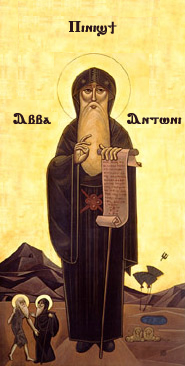
A religious habit is a distinctive set of religious clothing worn by members of a religious order. Traditionally some plain garb recognizable as a religious habit has also been worn by those leading the religious eremitic and anchoritic life, although in their case without conformity to a particular uniform style.
The Confraternities of the Cord are pious associations in the Roman Catholic Church whose members wear a cord, girdle, or cincture in honour of a saint whom they wish to honour and to bear in mind some special grace or favour which they hope to obtain through the saint's intercession.

In Roman Catholicism, the Sabbatine Privilege refers to a belief in the early liberation of souls from Purgatory, on the first Saturday after death, through the special intercession and petition of the Virgin Mary. The Privilege is based on an apocryphal Papal Bull Sacratissimo uti culmine, dated 3 March 1322 and attributed to Pope John XXII. The Bull is universally regarded by scholars as inauthentic.

The Fivefold Scapular, also known as Redemptorist Scapular, is a sacramental made up of five best-known of the early scapulars in the Catholic Church: the Brown Scapular of the Carmelites, the Blue Scapular of the Immaculate Conception, the Black Scapular of the Servites, the Red Scapular of the Passion, and the White Scapular of the Most Holy Trinity. There are 17 total officially approved scapulars of the Catholic Church.

Three Hail Marys are a traditional Roman Catholic devotional practice of reciting Hail Marys as a petition for purity and other virtues. Believers recommend that it be prayed after waking in the morning, and before going to bed. This devotion has been recommended by SS. Anthony of Padua, Alphonsus Liguori, John Bosco and Leonard of Port Maurice. Two saints, Mechtilde and Gertrude the Great, are said to have received revelations from the Blessed Virgin Mary regarding this practice.

The Secular Order of Discalced Carmelites, formerly the Secular Order of Discalced Carmelites of the Blessed Virgin Mary of Mount Carmel and of the Holy Mother Saint Teresa of Jesus, is a third order of Catholic lay persons and secular clergy associated with the Discalced Carmelites.
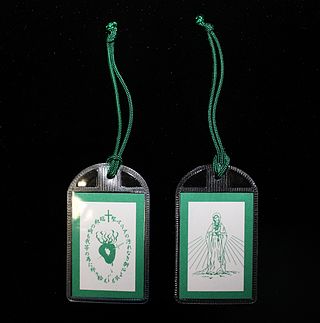
The Green Scapular is a Roman Catholic devotional article approved by Pope Pius IX in 1870. It is worn to gain the intercession of the Virgin Mary in the wearer's life and work, as well as (especially) at the moment of one's own death. Use of this article is generally understood to be more liberal than other scapulars; the favor it earns will apply to anyone who wears it, carries it, or simply keeps it aside. It can even be carried or kept by one party in the stead of another if circumstances impede the intended recipient to safely or practically accept it.
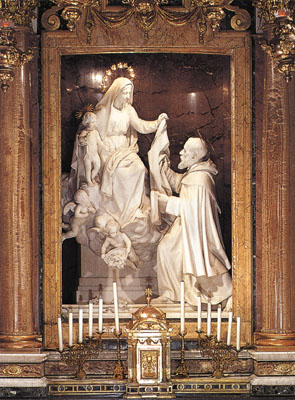
The exact origins of both the rosary and scapular are subject to debate among scholars. Pious tradition maintains that both the rosary and the brown Scapular of Our Lady of Mount Carmel were given by the Virgin Mary to Dominic and Simon Stock respectively during the 13th century. Historical records document their growth during the 16th and 17th centuries in Europe. By the early 20th century, they had gained such a strong following among Catholics worldwide that Josef Hilgers, writing in the Catholic Encyclopedia of 1914, stated: "Like the Rosary, the Brown scapular has become the badge of the devout Catholic."

The Blue Scapular of the Immaculate Conception is a devotional scapular that traces its roots to Venerable Ursula Benincasa, who founded the Roman Catholic religious order of the Theatine Nuns. This scapular must have a blue woollen cloth and on one side bears a symbolization of the mystery of the Immaculate Conception of Our Lady and on the other the name of the Blessed Virgin Mary.

The Scapular of the Sacred Heart is a Roman Catholic devotional scapular bearing an image of the Sacred Heart of Jesus on the front panel, and an image of the Virgin Mary as Mother of Mercy on the panel which hangs at the wearer's back. In its current form, the design and the formal church approval for its use are due to Estelle Faguette, a French domestic servant, who in 1876 claimed to have received a series of apparitions during which the Virgin Mary showed this scapular and spoke about its use.
The Archconfraternity of the Holy Face was established in Tours, France in 1876, by Archbishop Charles Colet; and raised to an Archconfraternity by Pope Leo XIII in 1885.

The Scapular of the Seven Sorrows of Mary is a Roman Catholic devotional scapular that dates back to the thirteenth century. It is worn by members of the Confraternity of the Seven Dolours of Mary, associated with the Servite Order.
In order to associate the faithful, who were not Oblates of St. Benedict, in a certain measure with the Benedictine Order, a Confraternity of St. Benedict was founded in the second half of the nineteenth century, at first by the English Congregation.
